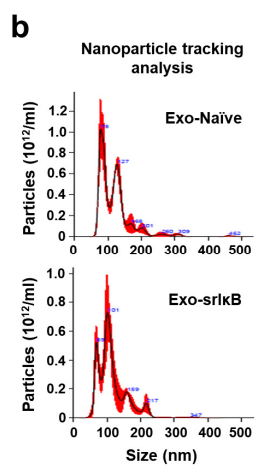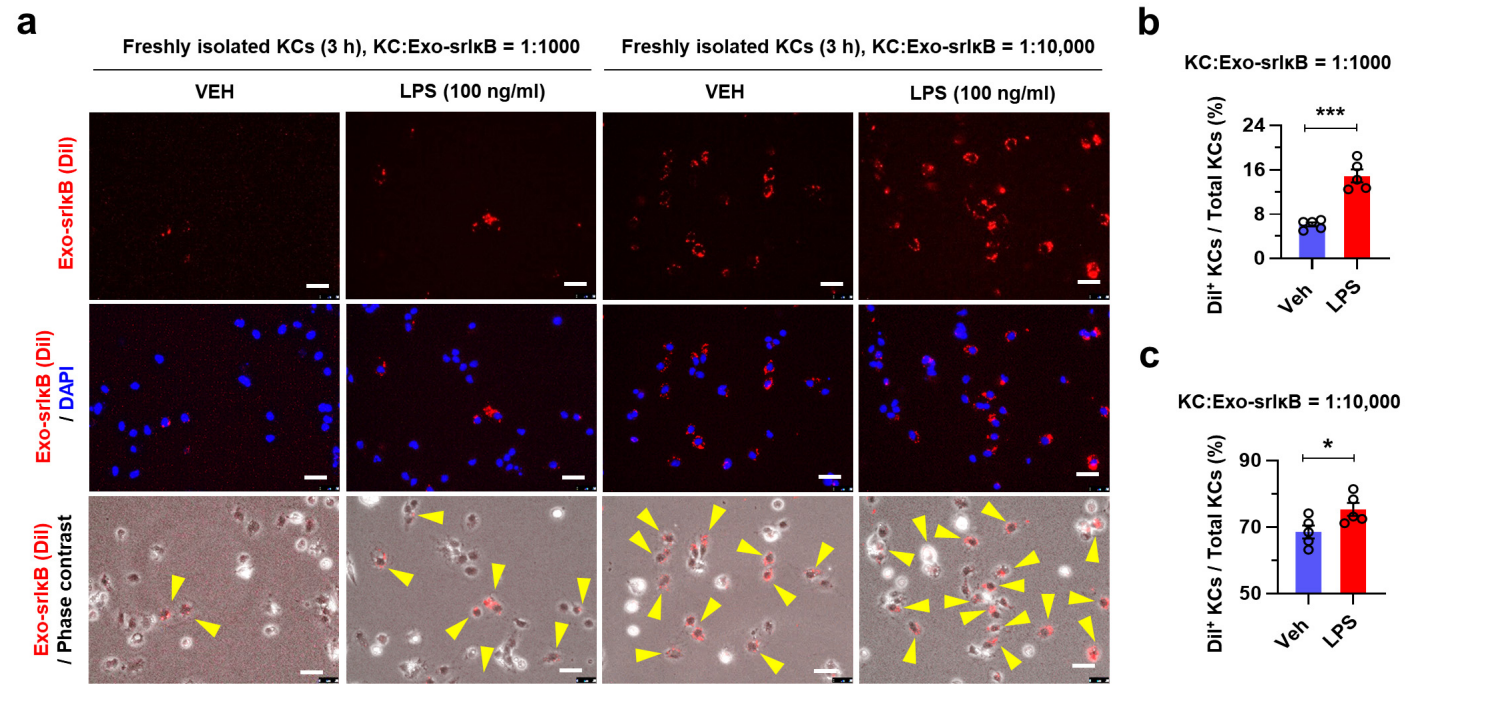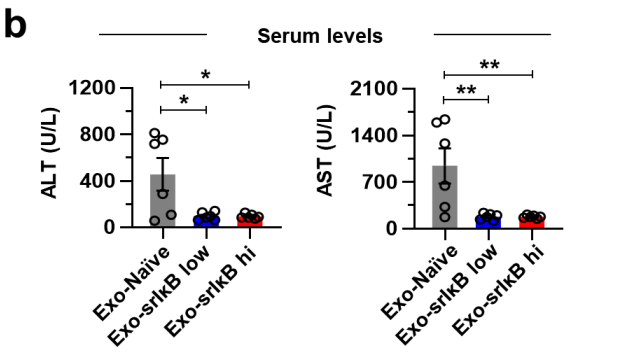Editor: Nina
This study demonstrates that exosome-based delivery of super-repressor IκBα (Exo-srIκB) effectively mitigates alcohol-associated liver injury in mice by targeting inflammation in Kupffer cells, highlighting its potential as a novel therapeutic strategy for alcohol-associated liver disease.
Key Preview
Research Question
Can exosome-based delivery of super-repressor IκBα (Exo-srIκB) effectively alleviate alcohol-associated liver injury in mice?
Research Design and Strategy
The study employed an experimental design involving in vivo animal models, specifically C57BL/6J male mice, to examine the effects of Exo-srIκB on alcohol-related liver damage.
Method
Researchers administered Exo-srIκB to mice subjected to chronic alcohol consumption and assessed various parameters, including inflammation, liver injury, and gene expression related to liver health.
Key Results
Exo-srIκB significantly reduced liver inflammation, apoptosis, and steatosis in the mice, particularly after multiple consecutive injections, indicating its potential as a therapeutic agent against alcohol-associated liver disease (ALD).
Significance of the Research
This study suggests a novel therapeutic approach targeting NF-κB signaling in Kupffer cells, offering hope for effective treatments for ALD, which currently lacks approved pharmacological options.
Introduction
Alcohol-associated liver disease (ALD) is a significant global health issue, stemming from chronic and excessive alcohol consumption. It encompasses a spectrum of liver damage, starting from fatty liver to severe conditions such as cirrhosis and hepatocellular carcinoma. The underlying mechanisms involve gut dysbiosis and the consequent hepatic influx of gut-derived endotoxins like lipopolysaccharides (LPS), which activate pro-inflammatory pathways in the liver. Recent advancements in nanomedicine have highlighted exosomes as promising drug delivery vehicles due to their ability to encapsulate therapeutic agents while minimizing off-target effects. This study investigates the use of exosome-based delivery of a super-repressor form of IκBα, designed to inhibit NF-κB activation, as a potential treatment for ALD.
Research Team and Objective
The study was conducted by a team of researchers, including Hee-Hoon Kim, Young-Ri Shim, and others from the Laboratory of Liver Research at KAIST and ILIAS Biologics Inc. The paper titled “Exosome-Based Delivery of Super-Repressor IκBα Alleviates Alcohol-Associated Liver Injury in Mice” was published in Pharmaceutics. The research aimed to explore the therapeutic potential of Exo-srIκB in mitigating alcohol-induced liver damage and its underlying mechanisms.
Experimental Process
Characterization of Exo-srIκB
- Key Steps:
Exosomes were engineered to encapsulate the super-repressor IκBα (srIκB) using a novel light-mediated protein interaction system. The production involved using Expi293F cells that were exposed to blue-light illumination to induce the association of the CRY2 and CIBN proteins, facilitating the loading of srIκB into the exosomes. - Results and Key Data:
The size and morphology of the isolated exosomes were confirmed through nanoparticle tracking analysis (NTA), revealing a diameter range of 50 to 130 nm. Transmission electron microscopy (TEM) images corroborated these findings, showcasing the distinct shape of the exosomes.
Figure 1. Representative panels for nanoparticle tracking analysis.
- Significance of the Result: This characterization is crucial as it establishes the successful engineering of Exo-srIκB, which is vital for its subsequent biological applications.
- Key Innovations: The use of optogenetic techniques to enhance exosome loading efficiency represents a significant advancement in exosome engineering.
In Vitro Delivery Assessment
- Key Steps: DiI-labeled Exo-srIκB was administered to LPS-treated mouse Kupffer cells (KCs) to evaluate the uptake efficiency. The delivery was assessed at varying doses and time points (1 and 3 hours).
- Results and Key Data: After 3 hours, approximately 70% of KCs at a high dose (KC:Exo-srIκB = 1:10,000) displayed uptake of Exo-srIκB, significantly enhanced by LPS treatment.

Figure 2. Indicated doses of DiI-labeled Exo-srIκB were treated to isolated mouse KCs with vehicle (saline, VEH) or LPS (100 ng mL−1 ) for 3 h (n = 5 per group). (a) Representative pictures of cultured mouse KCs. Scale bars, 50 µm. (b,c) The frequencies of DiI+ KCs among total KCs.
- Significance of the Result: The high uptake of Exo-srIκB by KCs indicates its potential for targeted delivery to inflamed liver cells, which is crucial for effective treatment of alcohol-associated liver disease (ALD).
- Key Innovations: Demonstrating specific targeting of activated KCs through exosome-mediated delivery showcases a novel strategy for enhancing therapeutic efficacy.
Single Injection Experiment
- Key Steps: A single intravenous injection of either Exo-srIκB or control exosomes (Exo-Naïve) was administered to mice before an acute ethanol binge (4 g/kg). The liver was analyzed 6 hours post-ethanol administration.
- Results and Key Data: Mice treated with Exo-srIκB exhibited significantly reduced hepatic steatosis and inflammatory gene expression levels compared to controls, though no significant changes in liver injury markers were observed.
- Significance of the Result: This finding suggests that Exo-srIκB can ameliorate early signs of liver damage, indicating its potential as a preventive therapeutic strategy in ALD.
- Key Innovations: The concept of using a single exosome injection to achieve significant therapeutic effects in a model of ALD highlights an efficient approach to treatment.
Multiple Injection Experiment
- Key Steps:
Mice received 3 consecutive daily intravenous injections of Exo-srIκB prior to ethanol binge drinking. Two dosage groups (low and high) were established for comparative analysis. - Results and Key Data: Treatment with Exo-srIκB led to substantial reductions in liver injury, apoptosis, and inflammatory responses, as evidenced by decreased ALT and AST levels, reduced apoptosis in liver tissues, and diminished inflammatory gene expression levels.

Figure 5. Serum levels of ALT and AST were measured.
- Significance of the Result:
The comprehensive reduction in various markers of liver damage underscores the enhanced therapeutic potential of repeated dosing of Exo-srIκB, providing a promising avenue for the treatment of ALD. - Key Innovations:
The demonstration that repeated exosome injections can produce cumulative protective effects against ALD represents a significant advancement in exosome-based therapies.
Mechanistic Insights
- Key Steps: The researchers examined the signaling pathways involved in the therapeutic effects of Exo-srIκB, particularly focusing on the NF-κB pathway in liver tissues. They performed Western blot analysis to assess nuclear translocation of NF-κB following treatment.
- Results and Key Data: Exo-srIκB treatment resulted in inhibited nuclear translocation of NF-κB and subsequent downregulation of pro-inflammatory cytokines in liver tissues.
- Significance of the Result:
This establishes a clear mechanistic link between Exo-srIκB administration and the attenuation of inflammatory signaling in the liver, validating the therapeutic approach. - Key Innovations:
Elucidating the specific molecular mechanisms through which Exo-srIκB operates in liver inflammation provides foundational knowledge that can be leveraged in designing future therapies.
Conclusion
The study demonstrates the protective role of Exo-srIκB in alleviating alcohol-associated liver injury via exosome-mediated delivery. By targeting inflammation in Kupffer cells, Exo-srIκB shows promise as a novel therapeutic strategy for treating ALD. The insights gained from this research pave the way for potential clinical applications and further exploration of exosome-based therapies in liver diseases.
Reference:
Kim, Hee-Hoon, et al. “Exosome-based delivery of super-repressor IκBα alleviates alcohol-associated liver injury in mice.” Pharmaceutics 15.2 (2023): 636.
